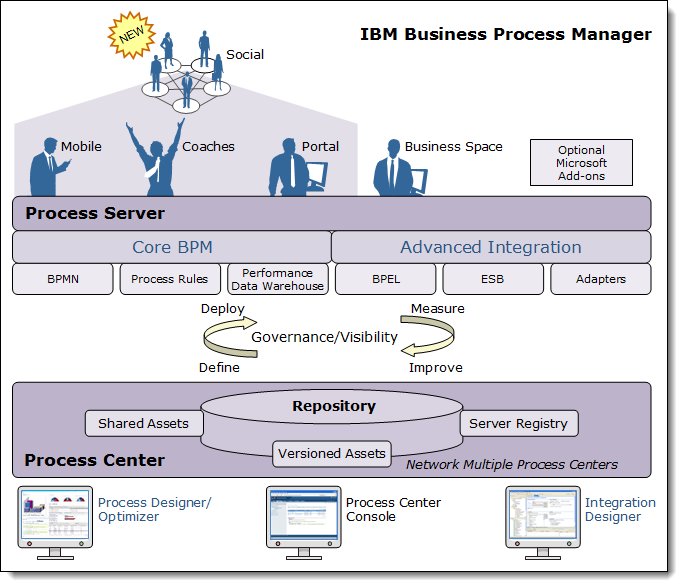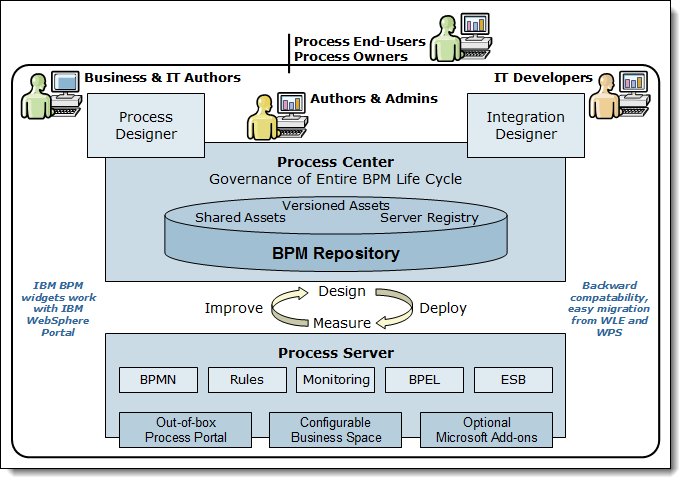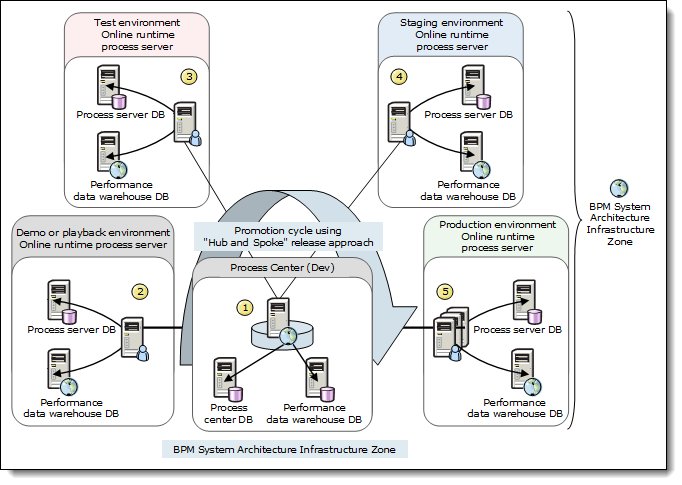Abstract
IBM® Business Process Manager is a BPM (business process management) platform that helps process participants gain enterprise-wide visibility of business processes, so that improvements can be made quickly by those who know the processes best. IBM Business Process Manager provides a “social BPM” approach toward process design and management. This approach greatly enhances collaboration among process participants in the organization, and provides the power and robustness required for mission-critical enterprise solutions.
This IBM Redbooks® Solution Guide provides an overview and architecture of the IBM Business Process Manager and includes typical usage scenarios.
Contents
IBM® Business Process Manager is a comprehensive Business Process Management (BPM) suite that provides visibility and management of your business processes. IBM Business Process Manager supports the whole BPM lifecycle approach, namely discover and document, plan, implement, deploy, manage, and optimize. It also includes tooling and run time for process design, execution, monitoring, and optimization. Process owners and business owners can use this solution to engage directly in the improvement of their business processes.
IBM Business Process Manager excels in integrating role-based process design and provides a social BPM experience. It enables asset sharing and versioning through Process Portals and Process Centers that act as unified repositories, making it possible to manage changes to the business processes with confidence. IBM Business Process Manager supports a wide range of standards for process modeling and exchange, and built-in analytics and search capabilities help to further improve and optimize the business processes.
The following figure is an overview of IBM Business Process Manager.

Figure 1. IBM Business Process Manager overview
Did you know?
Did you know that IBM offers domain-specific Industry Content Packs with IBM Business Process Manager? These Packs are designed to integrate seamlessly with IBM Business Process Manager, providing a set of prebuilt assets to help accelerate delivery of standards-based industry solutions for the banking, healthcare, and telecommunications industries. The following list is a small sample of the out-of-the-box capabilities provided by these Packs:
- New account opening
- Benefits eligibility
- Order handling and incidence and problem management
Business value
Processes, which should ideally define templates for activities, are often not visible, well understood, or measured correctly. They involve decisions that can be automated, improved, and made more consistently across organizations – but more often are not. And in cases where processes are visible, managed, or automated, actual business people often do not have access to improve or control them.
IBM Business Process Manager addresses these needs and provides the foundation for business-centric IT by:
- Automating critical business processes quickly to meet new efficiency objectives
- Promoting effectiveness and efficiency in the business processes by using measurable business value to align all projects with corporate strategies
- Using process monitoring and governance to ensure corporate and regulatory compliance
In short, IBM Business Process Manager can help to create, manage, measure, and continuously improve the processes that drive the business.
Solution overview
There are three versions of the IBM Business Process Manager, which are designed to match increasing levels of functional complexity. The highlights of each edition are identified in Table 1.
Table 1. Highlights of IBM Business Process Manager editions
| Edition | Phase |
| Advanced | Transformation Complete set of business process management capabilities:
|
| Standard | Program Configured for typical business process management projects:
|
| Express | Project Configured for first business process management projects:
|
IBM Business Process Manager consists of the following components:
- Process Center, including the Business Process Manager Repository
The Process Center provides the repository used for IBM Business Process Manager and the tools used to govern the lifecycle of business processes. Lifecycle management includes the deployment of processes to Process Server run times and creating and maintaining snapshot data.
- Process Server
Process Server provides a single IBM Business Process Manager runtime environment that can support a range of business processes, service orchestration, and integration capabilities. The Process Server enables running of processes as they are being built. Process Server executes processes and services that authors build using the Authoring Environments.
IBM Business Process Manager utilizes two authoring environments:
- IBM Process Designer
IBM Process Designer is an Eclipse-based tool used by business process authors. IBM Process Designer is available in all configurations of the product, and offers the capability to model and implement business processes as process applications. IBM Process Designer includes additional tooling (the Process Inspector and Process Optimizer), for interacting with processes running on the Process Center Server (playback server) or a connected Process Server deployment target.
- IBM Integration Designer
IBM Integration Designer is an Eclipse-based tool used by IT developers. IBM Integration Designer is only available in the advanced configurations of the product. IBM Integration Designer is used to author complex integrations and fully automated processes that support process applications designed in the IBM Process Designer. Using IBM Integration Designer, with a fully integrated testing environment using test cases and test suites, IT developers can build reusable SOA services, orchestrate those services, and access back-end systems.
The following figure shows the components of IBM Business Process Manager.

Figure 2. IBM Business Process Manager components
The way that IBM Business Process Manager operates is that processes are authored in the Process Center, which governs the entire lifecycle of the process. The business processes can be
developed (and authored) using the IBM Process Designer and IBM Integration Designer. These processes are subsequently published to the Process Server for runtime operation
Solution architecture
An IBM Business Process Manager solution can be deployed in various combinations. A typical environment consists of a central Process Center environment installing to a number of associated Process Server environments, with either just IBM Process Designer or both IBM Integration Designer and IBM Process Designer. This is typically set up in an on-line Process Server configuration, as depicted in the following figure.

Figure 3.Lifecycle of a Process Application
As you can notice in Figure 3, the Process Application also follows the normal software development lifecycle. The numbers in the figure identify the development and installation lifecycle of a Process Application across various environments:
- The Process Application snapshot is created.
- It is released for playback with the business.
- It is promoted for functional testing.
- It is released for staging or pre-production testing.
- It is deployed to the production environment.
Usage scenarios
The usage scenarios presented here describe actual solutions implemented with IBM Business Process Manager.
Banking sector scenario
Banking executives are looking for better ways to understand what their clients want and then deliver those products and services quickly. They understand that they must reduce the time it takes to get these products to market but are hindered by highly complex and inflexible banking processes. The current global financial environment increases the urgency for banks to automate, optimize, and integrate processes in a shareable and reusable fashion.
IBM Business Process Manager has prebuilt banking processes, service models, vocabularies, solution templates and dashboards that will jumpstart the delivery of BPM solutions. This prebuilt content is based on industry standards like ISO 20022, MISMO, SEPA, SWIFT, NACHA, and IFW, thereby ensuring consistency and compliance across multiple lines of businesses and geographies.
Telecommunications sector scenario
For many communication service providers today, the IT departments or product management groups, rather than the marketing and channels managers, own the creation and maintenance of the marketing programs. Setting up and modifying campaigns and promotions can take weeks or months to implement.
The IBM Campaigns and Promotions Accelerator for Telecom, part of the IBM Service Provider Delivery Environment Framework, helps speed the launch of concurrent multichannel campaigns and promotions to increase revenue streams and reduce churn. It helps service providers target the right promotion to the right customer at the right time based on real-time service usage patterns such as Call Detail Records (CDR) or network events, while providing the monitoring and reporting data to evaluate the campaign effectiveness.
Healthcare industry scenario
The healthcare industry faces multiple significant challenges today: healthcare provider attempts to deliver patient care efficiently, effectively, and safely; and patient efforts to manage and maintain personal health and wellness; both in spite of the shortage of accessible science at the point of care (that is, evidence-based care) and integrated methods for keeping current the medical common body of knowledge (CBOK).
IBM Business Process Manager can maintain the increasing CBOK while making critical, current data available to practitioners in a manner that is consistent with the evidence-based and event-driven environment to which healthcare aspires. BPM powered by Smart SOA also can automate healthcare provider administrative and care delivery processes to optimize enterprise operations and to maximize the safety and success of patient care.
Insurance industry scenario
To improve its overall responsiveness, a personal and commercial lines claims processing entity needed to drive efficiency and improve customer service by applying automation-enabled straight-through processing for high claims volume.
It leveraged BPM-enabled SOA framework coupled with legacy modernization. By also developing reusable claims services and implementing business rules management (BRM), business process manager, and Enterprise Service Bus (ESB) with full orchestration, the insurer achieved substantial ROI within the first six months of full production. Its primary challenges were to eliminate paper and automate via a straight-through processing implementation.
The automation of personal lines was the first implementation with a combination of BPM and BRM, along with scanning, imaging, and automated workflow. The results were astonishing: 60% of the claims were processed in real time and within three or four seconds — a significant improvement over the several days of processing time that was formerly required. Building off this framework, the company replicated the success in other lines of business.
Integration
IBM Business Process Manager is an important part of the IBM SOA stack and was intentionally designed to work seamlessly with other IBM products. Among the products commonly integrated with the IBM Business Process Manager are the following:
- IBM Business Monitor
Provides detailed business activity monitoring through customizable dashboards, notifications, and alerts to help improve business agility. The integration between IBM Business Process Manager and IBM Business Monitor allows monitoring of the business processes in greater detail, for example, tracking process and activity start times, stop times, and durations.
- IBM Case Manager
Business Process Management and Case Management are the two leading ways to manage business processes and documents. Together they present unified information, processes, and people to provide a 360-degree view of the case, thus forming a complementary and complete way of managing most complex, enterprise-level business transactions.
- IBM WebSphere Operational Decision Management
IBM WebSphere® Operational Decision Management allows managing decisions separately from business applications. The separation of decision management from application code reduces the amount of time and effort required to update the business logic in production systems, and increases the ability of an organization to respond to changes in the business environment.
- IBM WebSphere Message Broker
WebSphere Message Broker delivers an advanced ESB that provides connectivity and data transformation for both standards-based and non-standards-based applications. The integration between IBM Business Process Manager and WebSphere Message Broker allows IBM Business Process Manager to expose its services universally and extend its data transformation capabilities.
Many application environments provide simple, well documented interfaces to enable other components to access their capabilities. However, some popular applications have complex interfaces and arcane interaction styles. IBM Business Process Manager Advanced provides the following set of inbound and outbound adapters to ease the challenges of accessing some of the more popular application environments:
- CICS® (outbound)
- IBM Enterprise Content Management (inbound and outbound)
- IMS™ (outbound)
- Oracle JD Edwards EnterpriseOne (inbound and outbound)
- Lotus® Domino® (inbound and outbound)
- Oracle eBusiness Suite (inbound and outbound)
- PeopleSoft™ (inbound and outbound)
- SAP (inbound and outbound)
- Siebel (inbound and outbound)
In addition to adapters for applications, there are adapters that help in connecting to the following common technology infrastructures:
- Email (inbound and outbound)
- Flat files (inbound and outbound)
- FTP (inbound and outbound)
- iSeries® (inbound and outbound)
- JDBC Databases (inbound and outbound)
Supported platforms
The supported platforms for IBM Business Process Manager V8.0 are:
- AIX® (32- and 64-bit)
- Linux on x86 (32- and 64-bit)
- Linux on zSeries® (32- and 64-bit)
- Solaris on SPARC (32- and 64-bit)
- Windows (32- and 64-bit)
For detailed system requirements, see "IBM Business Process Manager Advanced detailed system requirements" at:
http://www.ibm.com/support/docview.wss?uid=swg27023005
Ordering information
The following table provides ordering information.
Table 2. Ordering information
| Program name | PID number | Charge metric |
| IBM Business Process Manager Advanced | 5725-C94 | Processor Value Unit (PVU) |
| IBM Business Process Manager Standard | 5725-C95 | PVU |
| IBM Business Process Manager Express | 5725-C96 | PVU |
| IBM Business Process Manager Tools and Add-ons | 5725-C97 | Authorized User Application Instance |
Related information
For more information, see the following documents:
- Scaling BPM Adoption: From Project to Program with IBM Business Process Manager
http://www.redbooks.ibm.com/abstracts/sg247973.html - IBM Business Process Manager Version 8.0 Production Topologies
http://www.redbooks.ibm.com/abstracts/sg248135.html - Business Process Management with IBM Business Process Manager
http://www.redbooks.ibm.com/abstracts/tips0938.html - Business Process Manager product page
http://www.ibm.com/software/integration/business-process-manager/ - IBM Offering Information page (to search on announcement letters, sales manuals, or both):
http://www.ibm.com/common/ssi/index.wss?request_locale=en
On this page, enter Business Process Manager, select the information type, and then click Search. On the next page, narrow your search results by geography and language.
Others who read this also read
Special Notices
The material included in this document is in DRAFT form and is provided 'as is' without warranty of any kind. IBM is not responsible for the accuracy or completeness of the material, and may update the document at any time. The final, published document may not include any, or all, of the material included herein. Client assumes all risks associated with Client's use of this document.
